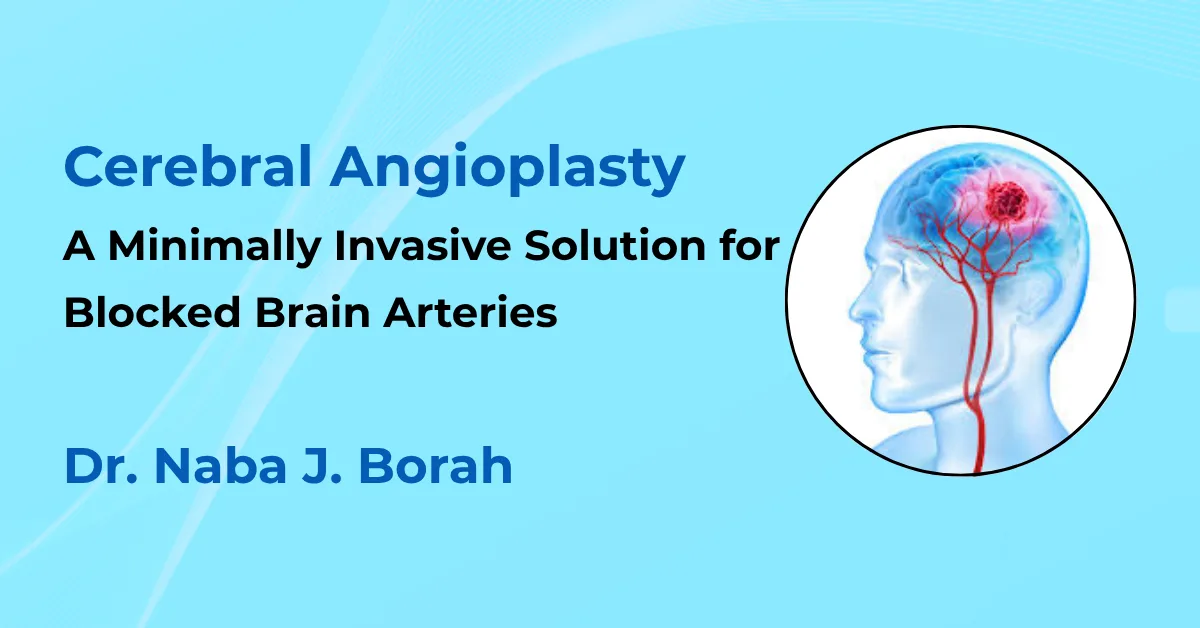Commonly Asked Medical Questions About Cerebral Angioplasty
- Can brain arteries get blocked like heart arteries?
- Is brain stenting available in India?
- What is cerebral angioplasty used for?
- Can blocked brain arteries cause stroke?
If you’re wondering the same, this guide will help you understand how cerebral angioplasty offers a path to recovery — especially if you’re at high risk for stroke.
What Is Cerebral Angioplasty?
Cerebral angioplasty is a neurointerventional procedure designed to open narrowed arteries within the brain. This restores healthy blood flow and significantly reduces the risk of an ischemic stroke — a stroke caused by a blood clot or artery blockage.
💡 Medical term simplified: “Angioplasty” means using a tiny balloon catheter to open a blocked blood vessel. “Cerebral” refers to the brain’s vascular system.
Why Is It Done?
Arteries in the brain can become narrowed due to atherosclerosis — buildup of fatty deposits inside the vessel walls. This narrowing reduces oxygen supply and raises the risk of:
- Stroke
- Transient Ischemic Attacks (mini-strokes)
- Sudden blackouts or vision loss
- Recurrent dizziness or imbalance
For patients who don’t respond to medication alone, angioplasty and stenting can be a lifesaving option.
What Happens During the Procedure?
- A catheter is inserted through an artery (in the wrist or groin)
- Under live X-ray (DSA), it’s guided into the intracranial artery
- A tiny balloon is inflated to widen the vessel
- Often, a drug-eluting stent is placed to prevent future narrowing
💡 Medical term simplified: Stent – a small, mesh-like tube that holds the artery open.
🛏️ No open brain surgery.
📆 Most patients are discharged within 2–3 days.
Dr. Naba J. Borah’s Expertise in Cerebrovascular Surgery
Dr. Naba J. Borah is one of the few neurosurgeons in Northeast India trained in both open neurosurgery and endovascular techniques, including cerebral angioplasty and intracranial stenting.
With over 10,000+ neurosurgeries successfully performed, he specializes in:
- Stroke prevention and treatment
- Aneurysm clipping and coiling
- Carotid and vertebral artery disease
- Complex neurovascular reconstructions
His approach combines advanced imaging (DSA, MR angiography), evidence-based decision-making, and personalized care.
Who Should Consider Cerebral Angioplasty?
You may be a candidate if:
- You have 70% or more narrowing of a brain artery (e.g., MCA, basilar, vertebral)
- You’ve had a stroke or TIA despite medication
- You experience:
- Temporary blindness in one eye
- Weakness or numbness in a limb
- Unexplained dizziness
- Speech or understanding difficulty
This is determined through neuroimaging and clinical evaluation.
Is It Safe?
When performed in specialized centers, cerebral angioplasty is safe and effective, with success rates of 80–90% in carefully selected patients.
Risks are minimal but may include:
- Minor stroke or clotting (rare)
- Vessel injury or re-narrowing
- Bleeding or reaction to contrast dye
What to Expect After the Procedure?
- Resume normal activity in 1–2 weeks
- May need lifelong antiplatelet medications (aspirin/clopidogrel)
- Periodic scans to monitor stent
- Lifestyle changes: blood pressure, sugar, and cholesterol control
Internal Links:
- Stroke vs. Brain Hemorrhage: Know the Difference and When to Act Fast
- Carotid Endarterectomy vs. Stenting – What’s Right for You?
External Links:
Cerebral angioplasty is more than just a procedure — it’s a lifeline for patients with severe brain artery narrowing. If medications haven’t worked and stroke risk is high, this minimally invasive option might be your best protection against future brain damage.
Contact Information
Dr. Naba J. Borah
Neurosurgeon, Health City Hospital, Guwahati
📞 Phone: +91-9864516798
💬 WhatsApp: +91-8404061190
🌐 Website: drnabajborah.com/contact-us
Disclaimer: For serious or life-threatening conditions, please visit your nearest emergency center immediately.

